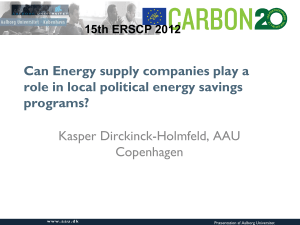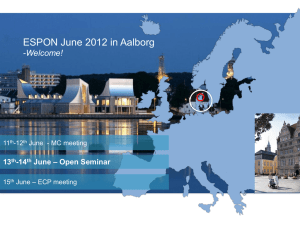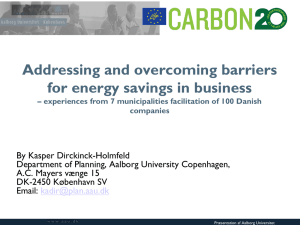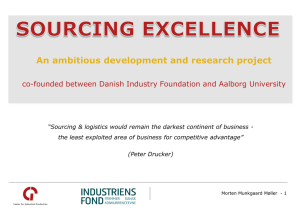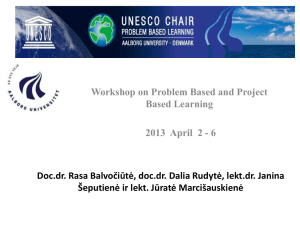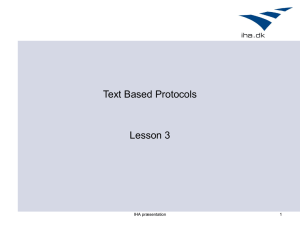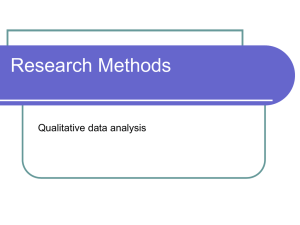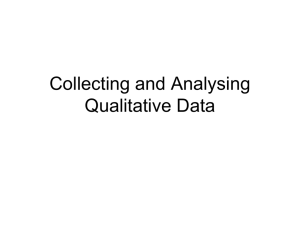Standardslides - Aalborg Universitet
advertisement
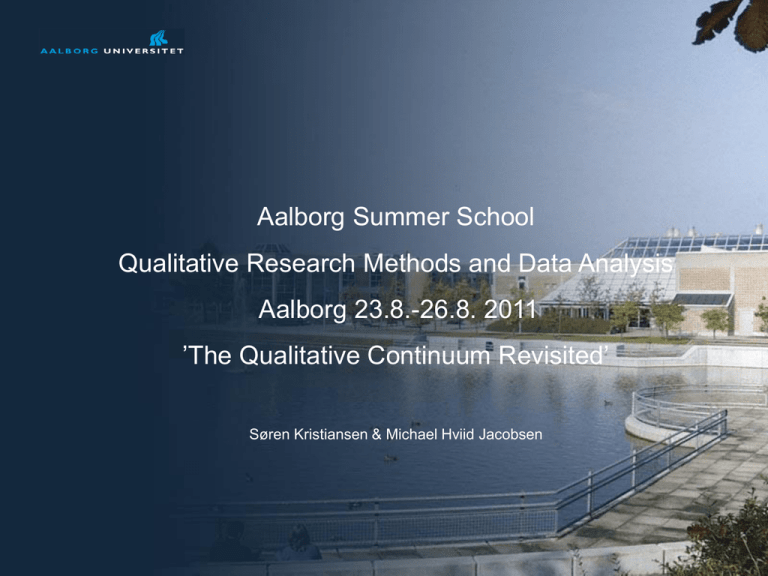
Aalborg Summer School Qualitative Research Methods and Data Analysis Aalborg 23.8.-26.8. 2011 ’The Qualitative Continuum Revisited’ Søren Kristiansen & Michael Hviid Jacobsen 1 Præsentation af Aalborg Universitet 1 af 31 Programme The Qualitative Continuum Revisited (part one): Data and theory links in qualitative research Various traditions; grounded theory, analytic induction, extended case method, recontextualising method Differences and similarities, strengths and weaknesess Implications in relation to qualitative research 2 Præsentation af Aalborg Universitet 2 af 31 The Qualitative Continuum 1.0. Grounded theory Analytic induction Extended case method Recontextuializing method - theory + theory + data - data Præsentation af Aalborg Universitet 3 af 31 Grounded theory A qualitative analysis and research strategy developed by Barney Glaser and Anselm Strauss in the 1960’s. Involves procedures for data sampling, conceptual saturation, distinctions between substantive theory and formal theory. General advice: Keep theory and research literature out of preliminary data sampling and analysis. The majority of GT-studies, however, adopts only selected elements from this approach. GT-studies typically generates theory/concepts from the data by way of relatively open coding strategies succeeded by code refinement. 4 Præsentation af Aalborg Universitet 4 af 31 Basic grounded theory concepts Theoretical saturation: is achieved when unexpected findings which may undermine the emerging theory no longer occurs. Difficult to determine when saturation is achieved, must be decided contextually by the researcher Theoretical sampling: the on-going collection of data material guided the categories that appear unsaturated. Sampling is thus not performed any pre-given systematics but strategically and specifically directed improving the emerging theory and its categories by the refining dimensions and properties Præsentation af Aalborg Universitet by by at of 5 af 31 Main contours of a GT-inspired analysis Categories or themes is generated directly from the data (in vivo or open coding) and chunks of data are categorized. Coded chunks of data is explored and compared. Preliminary and relatively unrestrained coding, that is: identification of categories and their properties and dimensions. Labeling/conceptualization is important. Axial coding: the categories are refined and related to each other. More systematic stage with focus on developing and refine code-hierarchies with categories and sub categories (by way of collapsing, splitting, eliminating codes). Development of a theory regarding a central theme of analysis. The selected theme is related systematically to the other themes (selective coding). Categories are thus linked and the theory is ’grounded’ in data. Glaser, B. & Strauss (1967): The Discovery of Grounded Theory. Chicago: Aldine/Gibbs, G. (2002): Qualitative Data Analysis. Buckingham: Open University Press/Roberts, K.A. & Wilson, R.W. (2002):ICT and and the Research Process. Forum: Qualitative Social Research, vol. 3. No. 2. 6 Præsentation af Aalborg Universitet 6 af 31 Grounded theory in practice KathyCharmaz (1980): The Social Reality of Death Identificed various types (categories) of approaches to the professional work with terminal patients among American hospital nurses Minimizing: Attempts to minimize effect of death on the daily routines and life in general by ignoring it or reframing it Hide away: Shielding and isolation of death and the dying, making it unperceptible and undisturbing to others Display(flaunting): Demontrative identification with the terminal patients and their relatives, confrontation and embracement of life’s end Recognition: Accept of the death as an inevitable part of life and a ’natural’ approach to the fact that people in fact dies. Præsentation af Aalborg Universitet 7 af 31 Theory: Categories: Properties: Dimensions: (continuum) Silence Minimizing Time – short/long Distance Embarrasment Staff strategies for handling death on a hospital ward Hide Away Display Recognition Præsentation af Aalborg Universitet 8 af 31 Advantages of grounded theory: Requires close contact with the field under study Enables a creative and flexible research proces Stimulates valid relations between ‘first’ and ‘second order’ concepts Challenges of grounded theory : ‘No- end’ frustrations. Difficult to determine the end point of thery development, when is the theory saturated? Difficult to avoid early impact from previously absorbed theoretical knowledge Præsentation af Aalborg Universitet 9 af 31 Analytic induction Development of theory ”bottom-up” – contrast to defining terms in advance of research Theory development as continuous effort of matching emergent theory and empirical material. Starts with a preliminary narrative/hypothesis which describes the field under study, then the researcher looks for (negative) cases that challenge the preliminary conceptual structure. By confronting the preliminary narrative/hypothesis with negative cases, the categories in the narrative is modified until the observed cases match the narrative/the explanation. Often focus on temporality, careers 10 Præsentation af Aalborg Universitet 10 af 31 Analytic induction in practice Becker, H. (1953): Becoming a Marihuanna User. American Journal of Sociology, 59 (3), 235-242 Point of departure: Traditional multi-variable analysis assumes that all the factors which operate to produce the phenomenon under study operate simultaneously. Becker’s critique: All causes do not operate at the same time and do have different impacts in different stages of people’s lives. We need, then ”a model that takes into account the fact that patterns of behavior develop in orderly sequence” of stages/changes (the career concept) Qualitative interview material (50 interviews) in order to develop a general statement of the sequence of stages which always occurred when individuals become willing and capable of using marihuana for pleasure Final theory: An individual will be able to use marihuana when he (1) learns to smoke it in a way that produce real effects, (2) learns to recognize the effects and connect them with drug use and (3) learns to enjoy the sensations he percieves. 11 Præsentation af Aalborg Universitet 11 af 31 Analytic induction in practice Michael Flaherty (2003): Time Work: Customizing Temporal Experience. Social Psychology Quarterly, 66, 17-33 Focus: How people create or manipulates various temporal experiences. Large qualitative interview material focussing on how people attempt to manipulate the experience of time. Initial reading produced a set of themes and variations. Each new interview was analyzed in terms of match (or lack of match) with already formed categories. Negative cases resulted in reformulation of preliminary categories. End product: A classificatory scheme covering the entire empirical material. Theory: People practice time work through attempts to manipulate: duration (i.e. to make situation last longer/shorter), frequency (i.e. to make something happen more often/seldom), sequence (i.e. to make something happen in a certain order), timing (when something is happening)… 12 Præsentation af Aalborg Universitet 12 af 31 Extended case method (ECM) Initiated by British antropologists in the 1960 and developed further by Michael Burawoy Point of departure: Narratives are already theoretical (because people strive for finality and orderliness) before the researcher enters the scene, therefore research should start with theory, move to the field and then back to theory The case under study is formed from the ’outside’ that is through theoretical framing – in contrast to GT where the case is formed by ethno-narratives (people’s lived experience). Without a theory that states the kind of empirical observations that ought to be, the chosen setting loses it’s contours as a critical case. Focus is on phenomena that challenges theory. Extended case method: The case is used to say something about underlying structural relations by way of theory. Aim: to develop or extend existing macro-level theory 13 Præsentation af Aalborg Universitet 13 af 31 Extended case method in practice Michael Burawoy (1979): Manufacturing Consent: Changes in the Labor Process under Monopoly Captalism. Chicago: University of Chicago Press Ethnographic study in large engineering factory. Focus: the ways in which the workers (in contrast with their objective interests) engage in labor (consent to labor) and how capitalist macro-forces affect the work situation Point of departure: Gramsci’s neomarxist theory of hegemony Observation: Workers shift between (1) working hard on attractive and ‘easy’ deals and (2) reduce their engagement on ‘stinker jobs’. Leads to development of Gramscis theory: By allowing workers to ‘take advantage’ of the system in the micro-level, management prevents that workers organize themselves against management interests. Factory-work is situated in a overall macro-sociological context (i.e. structural changes in the US labor market). 14 Præsentation af Aalborg Universitet 14 af 31 Advantages of ECM: The explanation of exeptions/deviant cases adds complexity to the analysis which might be overlooked in studies searching for similarities across different contexts Integrates the agency and micro-world of agents witt the impact from external macro-structures. Focus on how actors are determined by but also act upon (oppressing) structures. Builds on existing theory (making good theories better instead of inventing everything from scratch) Challenges of ECM: New insights is produced within the frameworks of á priori categories – limits to scientific progress? Distanced narratives tend to neglect people’s first-hand experiences, aristocrat ethnography or ‘theory singing’ 15 Præsentation af Aalborg Universitet 15 af 31 Recontextualizing method The organisation of a (new) empirical field in accordance with the principles of a known model or theory – a new context for a known phenomenon Progressive development of understanding by way of mirroing of empirical material in the new model. The application of’new’ frames of interpretation in the exploration of layers of meaning Creative abduction: The perception of a phenomenon from a new framework. The framework organizes data in a new way which leads to recognition of neglected meanings in the empirical material 16 Præsentation af Aalborg Universitet 16 af 31 Recontextualizing method in practice Goffman, E. (1959): The Presentation of Self in Everyday Life. New York: Doubleday Point of departure: The understanding of people’s role-behavior and ongoing formation of social structures can be facilitated by percieving them as actors on a stage. Focus on people’s faces, masks and performances. Inspiration from Burke & Bateson, extends with concepts like scene (the social situation in which interaction takes place), audience (those who percieve without taking part), manuscripts (the communication that flows among actors), regions (the front- and backstage of actor’s role-behavior) Various kinds of empirical illustrations, i.e. dating behavior, literature, etiquette manuals Result: Identification of ground rules: We try to control the impression we make on others, to stage a certain ‘self’ and to make interaction smooth and convenient. Although social behavior seem spontaneous, it is socially patterned and by our role-behavior we participate in the on-going reconstruction of the social order. 17 Præsentation af Aalborg Universitet 17 af 31 Recontexualizing method in practice Torben Berg Sørensen (1995): Den sociale samtale. Microsociological (conversation analysis) study of meetings of clients and social workers. The meeting conceptualized by Goffman’s ritual metaphor. Social workers assume a respecful strive for equality and present themselves as less powerfull than they are, they perform ‘self-reducement’ and equals out distance to clients. Execution of power and decision-making is accompanied by ‘healing-rituals which displays the client-professionalrelation as one of equality. Equality-styled conversation. The artificially produced equality promotes a certain style of conversation (on economic and material matters) which makes little room for the client’s most prominent problems (emotional matters in relation to social events such as divorce, lost jobs etc) By way of the metaphor (interaction as ritualized care) an understanding of the structuring of the conversation and possible and impossible themes (in the articificially produced relation of equality) is facilitated. 18 Præsentation af Aalborg Universitet 18 af 31 Boiled down to two main tracks Teory-driven fieldwork and analysis Data-driven fieldwork and analysis Definition of case/phenomenon by way Understanding of case/phenomenon of theory as a specific empirical thing present in the world and observable in the narratives of the field Re-development of general theory by use of empirical examles. Theory modification Formulation of specific theory on the basis of empirical cases (cross sectional) How ’invisible’ historical-structural forces’ on the macro-level affect people’s life and behavior What people, located in specific times and spaces, do with each other The effect of social laws (objectivism). People’s life-world experiences (subjectivism). Theory known in advance Theory is formed and developed in accordance with the ethno-narratives experienced by the researcher Præsentation af Aalborg Universitet 19 19 af 31 …and how their proponents tend to see each other ”Often this takes the form of a researcher’s finding ‘problems’ through a debate within the academy, through ‘theoretical considerations’, and thus justifying overriding evidence that the people studied do not define their situation as problematic or that they define their situation as problematic in ways the researcher ignores […] This posture inevitably leads to an assertion of false consciousness made from a position of presumptive superiority: what the people studied define as their reality itself is a product of powers they fail to appreciate” (Katz, 2004:288) The ordering of the social world is always theoretical. To claim that the narrative of the field emerges inductively from the field alone is nothing but an epistemological ‘fairy tale’ (Wacquant 2002:1481). 20 Præsentation af Aalborg Universitet 20 af 31 Some ground rules Define the problem/theme precisely Watch out for over-emphasizing one single explanation Find explanations on the problem/phenomenon in data (and thus not only in theory) Let actors appear Recognize the context of the problem/phenomenon(temporal, structural) 21 Præsentation af Aalborg Universitet 21 af 31

